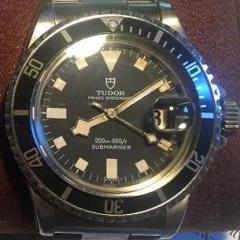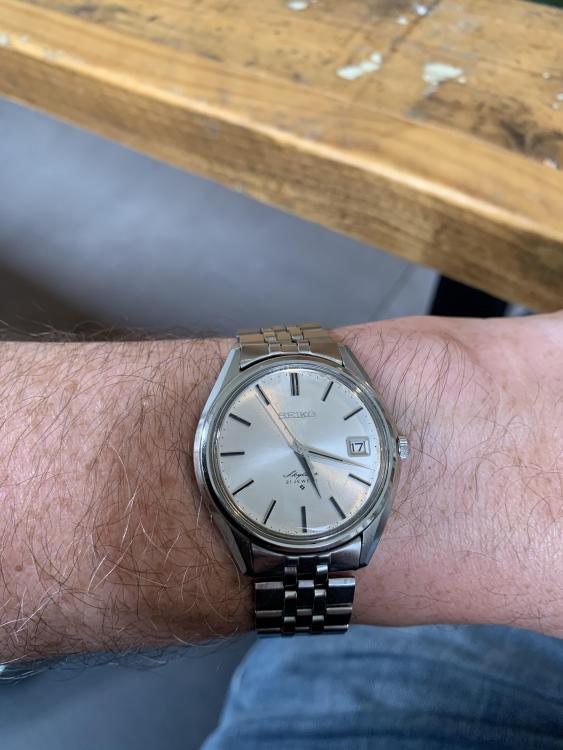Leaderboard
Popular Content
Showing content with the highest reputation on 08/31/20 in Posts
-
@AndyHull - I’m curious to know what you said when you found it! i misplaced a lovely clean Tissot my wife bought me when we lived in Switzerland. Looked high and low, was gutted. A few countries and change of addresses later, I was rummaging through a fancy picnic bag we’d bought whilst living next to Lake Geneva.There it was! Last time I’d worn it was my birthday-middle of October 2006 -it was a late heatwave and a bunch of us had gone for a swim in the lake ..water was 25oC! I’d put the watch in one of the picnic bag pockets, one of the lads then badly cut his foot, he ended up in hospital. when I found it - huge sigh of relief and me saying to the watch “ahhh - there you are!” on a completely different note, my catch from a few days back - first time wearing it. ’69 Seiko Skyliner. Got it with original box and guarantee. It’s not usually my thing, but it has a simple classic look and feel that’s unlike most of my other watches.3 points
-
It's assumed by People new to watch repair that technical bulletins exist for every single watch and the reality is they do not. Even for a company like Omega there is no technical service bulletin for the 613. As you've discovered there will be a parts list. But I see that rodabod Indicates there is one and I doubt there was perhaps. As this is a basic manual wind watch Omega would assume that whoever servicing their watches would understand how to lubricate a basic watch. The first link I have below is there because I like to know what I'm looking. Then looking at rodabod's Response above we will notice all the watches in the same family. So perhaps they have a service guide for you and the answer is no. At one time they might I had the service guide but today it's parts lists only. Then even the parts lists are somewhat fragmented in that the base caliber will have all the parts. The movements that have additional features will have a parts list only covering the different parts for that particular watch. Then sometimes there will be a service manual for generic problems of specific families. But as far as a Intel Omega does not have at least anymore service bulletins for the watches. But what Omega does have an it had them for a very long time is the supplemental stuff related to generic things like lubrication. Because obviously as they change their recommendations on lubrication they would want the people the field to know that. The second link their working instructions at least a few of them scroll down until you get the lubrication. Then when you looking at the Omega stuff you got off cousins notice how each corner is watermarked apparently Omega's paranoid over who's distributing their technical sheets. Which probably explains why anyone that has current access doesn't want to share because anyone is paranoid probably doesn't make people sharing.Although it could be worse as far as I can tell Rolex only provides their information now on line and supposedly it can't be copied. Rolex used even give out notebooks of generic information to the students in the schools that they sponsor and they don't do that anymore either at least there is some Omega stuff out there versus Rolex were anything currents were never going to see. http://www.ranfft.de/cgi-bin/bidfun-db.cgi?10&ranfft&0&2uswk&Omega_613 https://www.cousinsuk.com/document/search?SearchString=Working3 points
-
Hi I dont think there is a right or a wrong answer to this but to try and reduce the factors. Removing it from the case and removing the dial and hands is basically stage one and if the fault persists move foreward from there by degrees.2 points
-
A bad depth is another possibility (wear, excessive side-shake) and a deformed tooth.2 points
-
Remove the hands and dial plate, bench test in wind and set position sepeartely.2 points
-
I had a titanium case with titanium back (dumb) that galled and would NOT come off. Gasket was actually fine; Ti on Ti galls, and is as good as welded. I got it off by using a can of "air" blower, inverted to release the super-cold fluid. This shrunk the back enough that the (correct) tool could get it free. Once it was off, I polished the threads on the back and case; applied Aerospace anti-gall compound and reassembled. Moral of the story is: try freezing it off. A piece of dry ice will probably work. But, my honest opinion, and what I'd personally do in your position (despite my three generations of tools for all sorts of stuff), is I'd send it back to Zenith in Switzerland for a restoration. Yes, it will cost more than an independent, but they will have the parts, tools and expertise to restore it properly. They'd probably enjoy it too. I saw how nice that original bracelet is from the back, and it deserves to be done right.1 point
-
1 point
-
Judging from the many replies, I'd say you'd have to look at everything! Reminds me of Nuce's suggestion, but do remove the hands and the dial too. If that solves the problem you'll know for sure where to look.1 point
-
Right now just put the balance wheel back in without the fork and get decent photographs for us I'm in agreement with do not remove the hairspring because unless you have the right tools or more importance unless you know how and what you're doing You just going to make things worse.1 point
-
You can use a safety razor to remove the hairspring, insert the blade into the seam between collet and balance(collet seat) , work your way around the staff to widen the seam you can then insert a screw driver blade instead and gradually lift. I don't think you need to remove the hairspring though. I bet if you raise the stud to rasie the lower bend of the overcoil , you will see it was the lower bend hitting on spokes.1 point
-
Ahh one other thing if all else fails, check the stud point on the balance rim or mark it and remove the spring and run the balance wheel in the watch without the spring and the pallet and re check the rotation for freedom. Its a bit of a faf but requires logical progression. The fault exists with the pallet removed and the jewels checked so the next step is to remove the spring and test again.1 point
-
Interesting all the jewels and end stones look clean and free of imperfections. I when re assembled the fault still exists turn your attention to the balance spring. I am still suspicious of the fact it comes to an abrupt stop as though its setting on some spot, strange.1 point
-
base on how smooth it takes to set time. I dont think canon pinion is the problem.1 point
-
I have the document for 550-565; also covers 750-752. Your caliber is not specifically listed, however I assume the "general information" would be accurate. Fairly recent so it should have the modern lubricants. Nope. Just a parts list. Omega 552.pdf1 point
-
No idea if this is the problem, but how well is the canon pinion operating? I had one that was not perfectly round (I guess) and that drag would stop the movement.1 point
-
Combination of misaligned pallets and excess end shake of fork arbour, if gone unchecked can keep us guessing for quite sometime.1 point
-
One of the problems with watch repair is the age of the technical information. A problem with the age of the material is it's possible that things have changed like even fixodrop? Like for instance at the link below there is variations lots of them? Plus they've changed the solvent to something more environmentally supposedly friendly. Changing the solvent has had other interesting changes. For instance 7061 This one's interesting wash resistant if you download the technical sheet it tells how to apply it. Then since I really enjoyed the answer "NO" up above I'm going to quote something "Fixodrop-treated anchor pallets should be lubricated only after running dry for 1 to 2 minutes" Unlike the answer "NO" up above it's okay because it's only the pallet stones. You need to remove the surface treatment so the oil will stick otherwise you're going to have issues. Then they explain the drying procedure. This is interesting because the previous solvent they were using would evaporate so fast that if you weren't very very careful the cooling effect would cause moisture to condense out of the air eaving a microscopic coloring of moisture on your nice clean steel parts which leads to rust. This is why shops using this a lot of times I have a hot hairdryer radius and is a part came out that immediately put hot air on to hopefully avoid this. Now it's supposed to be better and not have that happen. Only the end stone should be treated not the setting. http://www.moebius-lubricants.ch/en/products/epilames1 point
-
Hmmm just a guess. The second wheel is fine. Before the movement stop the hands doesn't run like crazy. So it should be something concerning the winding and mainspring barrel.1 point
-
Do you have a nice straight line on the time grapher, when graphed over long periods? Does it stop when worn on your wrist? Does it start again when wound? Does it feel fully unwound when it has stopped?1 point
-
I’ll have to look on my external drive at work tomorrow. Maybe I have something as I’ve been collecting documentation for a long time and have learned to grab stuff even if “I’ll never need that”. No guarantees but the basic lubricant advice above seems sound. When these were new there wasn’t a lot of choices...1 point
-
Run the movement with the pallet jewels dry for some minutes, this allows the escape teeth to scrape off the epilame from them and that non-epilamed "track" holds the oil.1 point







